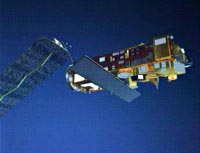Envisat prepares to start work

Envisat’s ASAR fully deployed
Since its successful launch into sun synchronous orbit on the morning of the first of March, Envisat has been getting ready to start observing the Earth.
Its 70 m2 of solar arrays are fully deployed, thus enabling it to obtain power from the Sun, and the ASAR antenna is now extending to its full 10 m, ready for its deployment in space. This will bring to an end the Launch and Early Orbit Phase.
The next step is the Switch on and Data Acquisition Phase that starts today. One by one, each of the 10 instruments on board will be turned on during the next few days, the instruments calibrated and a first verification of the data carried out. These activities are essential to guarantee the quality of the data that ESA will provide to Envisat users.
This phase will involve more than 200 people, including ESA staff and scientists all over the world, and entail the use of ground calibrators, ships, buoys, planes or balloons. As soon as the calibration and validation activities are completed, the delivery of data to Envisat users will start, a process expected to commence in September this year.
Tonight it is the turn of the Ka-band antenna to be released. This antenna will be used to transmit data, via Artemis, to a ground station located at ESA/ESRIN in Frascati, Italy, to ensure that data will arrive in near-real time.
Would you like to know more about how the data supplied by the 10 state-of-the-art instruments on board Envisat will help to protect the Earth and how the instruments work? Do you know exactly where Envisat is at present?
Our new site Envisat Expected Results contains text, photos and videos. All this information should help to answer your questions as well as explain why scientists all over the world are eagerly awaiting the data that Envisat, ESA’s new Earth observation satellite, will soon provide.
Media Contact
All latest news from the category: Earth Sciences
Earth Sciences (also referred to as Geosciences), which deals with basic issues surrounding our planet, plays a vital role in the area of energy and raw materials supply.
Earth Sciences comprises subjects such as geology, geography, geological informatics, paleontology, mineralogy, petrography, crystallography, geophysics, geodesy, glaciology, cartography, photogrammetry, meteorology and seismology, early-warning systems, earthquake research and polar research.
Newest articles
Faster, more energy-efficient way to manufacture an industrially important chemical
Zirconium combined with silicon nitride enhances the conversion of propane — present in natural gas — needed to create in-demand plastic, polypropylene. Polypropylene is a common type of plastic found…

Energy planning in Ghana as a role model for the world
Improving the resilience of energy systems in the Global South. What criteria should we use to better plan for resilient energy systems? How do socio-economic, technical and climate change related…

Artificial blood vessels could improve heart bypass outcomes
Artificial blood vessels could improve heart bypass outcomes. 3D-printed blood vessels, which closely mimic the properties of human veins, could transform the treatment of cardiovascular diseases. Strong, flexible, gel-like tubes…





















